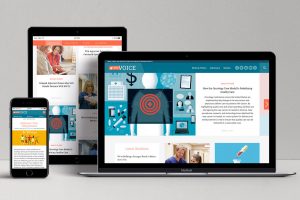
Read about the thinking behind the association magazine website design including strategy, design, interactive technology, and integrated advertising that is powering the news, views and advocacy engine for Oncology Nursing Society.


Read about the thinking behind the association magazine website design including strategy, design, interactive technology, and integrated advertising that is powering the news, views and advocacy engine for Oncology Nursing Society.

With people relying on mobile more than ever – over half of the trillions of Google searches happen on mobile – Google recently announced changes to favor the mobile experience. Google is calling this the biggest change since AdWords launched 15 years ago, and in my 10+ years experience working in the platform, I would agree! […]

Design for mobile first? No way. I was in denial. People couldn’t possibly enjoy trolling the Internet more on their smartphones than through their computers. Or could they? I thought about my own habits. Wake up. Check Facebook. Go about my morning routine. Get ready to leave the house. Facebook. Drive to work. Facebook. Go […]

Recently, we launched a landing page for Bryant University. This site asked the question “Why Bryant University?” and was completed in a tight two week turn around. Seemed like a walk in the park. It was anything but that. Thanks to our amazing design team and our thoughtful and motivated clients, Why Bryant sparks your […]

Gift development officers and nonprofit fundraisers are masters of being responsive to donors. However, there’s a new type of responsive philanthropy that you might not be thinking about — responsive website design (RWD). Don’t worry. We’re not going to get technical here. What most nonprofit fundraisers recognize is the significant migration to mobile (smartphones, tablets, […]

This is part 1 of my 3 part blog post about the best solution to your .edu website. Please stay tuned for the following posts. Now that nearly a quarter of web traffic is coming from mobile devices*, we’ve come to a crossroads over the best solution to a large webpage such as an .edu […]

Here at Elliance, we practice what we preach — sending responsive emails just as we encourage our clients to do. Our upcoming newsletter will be our first. (If you don’t currently receive the newsletter and want to check out the result, contact us with the ‘Sign Up for Newsletter’ box checked.) The importance of making […]

As Responsive Design has matured to a position of dominance in the web design and development world, so have our heads been filled with anecdotal evidence (i.e., non-evidence) about the ROI of Responsive Web Design. (Just for fun, I propose call this ROIRWD and, furthermore, that we agree henceforth to pronounce it “roy-ward”.) Now, of […]

I just returned from a vacation where I was reminded that my mobile apps are only as good as my cell provider’s data coverage. Before heading out on vacation, I downloaded a very popular trails app because it had great location information: a compass plus your latitude and longitude, weather, wind, sunrise and set, and […]

This morning I was reading a post on the Travel 2.0 Blog that hit home. Troy Thompson wrote: “Recently, I was asked to critique changes to an advertising campaign from a well-known tourism destination. While the creative was fine…amazingly not touting anything and everything…the call to action seemed, cluttered. Perhaps that was because it featured […]